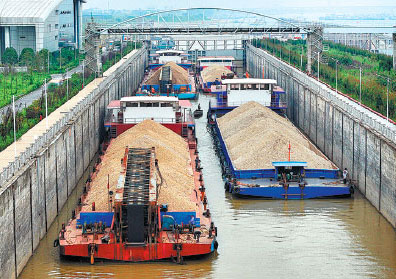 |
|
A navigation lock in operation in Xiangjiang River in Changsha, Hunan province. [Photo/Xinhua]
|
China will dredge sections of the Yangtze River this year to deepen it and increase the amount of freight traffic that can use the waterway, a national legislator said recently.
“Projects will be carried out on the upper, middle and lower reaches of the Yangtze River,” said Tang Guanjun, deputy to the National People’s Congress and also director of the Changhang River Administration of Navigational Affairs in Hubei province.
“We aim at forming a water network connecting more places,” he said.
“The water level is of prime importance to freight transportation on the river. For every 10 centimeter rise in the water level, a 3,000 metric ton ship can carry an extra 176 tons of cargo,” he said.
“The ‘golden water gateway’ is essential to boosting the development of the Yangtze River Economic Belt. The river’s mainstream is the busiest river in the world regarding freight traffic,” Tang said.
In 2016, freight traffic on the mainstream of the Yangtze River was 2.31 billion metric tons, while railways across the country carried 3.33 billion tons. The river handled 15.2 million containers last year.
“Water transportation is much cheaper than rail and road transportation,” he said.
New projects will be carried out under strict environmental rules, Tang said.
“We will build a green navigation channel, including using environmental materials and technology to avoid water pollution, and use an ecological design to allow fish to migrate and plants to grow,” he said.
The projects will be carried out on the mainstream and its tributaries.
After the project is completed, the river will be navigable for bigger ships, allowing them to be able to load and unload cargo along the middle and upper reaches of the Yangtze River.
Bottlenecks affect freight transportation traveling to the middle and upper reaches of the river.
The increase of freight traffic along the river is an important part of the Yangtze River Economic Belt, one of China’s three major national strategies.
The economic belt covers 11 provinces and cities, such as Jiangsu, Zhejiang, Anhui, Sichuan and Shanghai, with a total area of 2.05 million square kilometers. The belt also spans the country’s eastern, middle and western regions, and its population and GDP account for more than 40 percent of the national totals.
